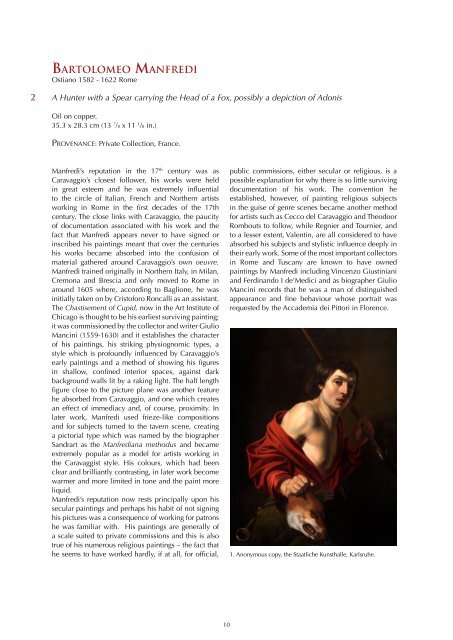Create successful ePaper yourself
Turn your PDF publications into a flip-book with our unique Google optimized e-Paper software.
Bartolomeo Manfredi<br />
Ostiano 1582 - 1622 Rome<br />
2<br />
A Hunter with a Spear carrying the Head of a Fox, possibly a depiction of Adonis<br />
Oil on copper.<br />
35.3 x 28.3 cm (13 7 /8 x 11 1 /8 in.)<br />
Provenance: Private Collection, France.<br />
Manfredi’s reputation in the 17 th century was as<br />
Caravaggio’s closest follower, his works were held<br />
in great esteem and he was extremely influential<br />
to the circle of Italian, French and Northern artists<br />
working in Rome in the first decades of the 17th<br />
century. The close links with Caravaggio, the paucity<br />
of documentation associated with his work and the<br />
fact that Manfredi appears never to have signed or<br />
inscribed his paintings meant that over the centuries<br />
his works became absorbed into the confusion of<br />
material gathered around Caravaggio’s own oeuvre.<br />
Manfredi trained originally in Northern Italy, in Milan,<br />
Cremona and Brescia and only moved to Rome in<br />
around 1605 where, according to Baglione, he was<br />
initially taken on by Cristoforo Roncalli as an assistant.<br />
The Chastisement of Cupid, now in the Art Institute of<br />
Chicago is thought to be his earliest surviving painting;<br />
it was commissioned by the collector and writer Giulio<br />
Mancini (1559-1630) and it establishes the character<br />
of his paintings, his striking physiognomic types, a<br />
style which is profoundly influenced by Caravaggio’s<br />
early paintings and a method of showing his figures<br />
in shallow, confined interior spaces, against dark<br />
background walls lit by a raking light. The half length<br />
figure close to the picture plane was another feature<br />
he absorbed from Caravaggio, and one which creates<br />
an effect of immediacy and, of course, proximity. In<br />
later work, Manfredi used frieze-like compositions<br />
and for subjects turned to the tavern scene, creating<br />
a pictorial type which was named by the biographer<br />
Sandrart as the Manfrediana methodus and became<br />
extremely popular as a model for artists working in<br />
the Caravaggist style. His colours, which had been<br />
clear and brilliantly contrasting, in later work become<br />
warmer and more limited in tone and the paint more<br />
liquid.<br />
Manfredi’s reputation now rests principally upon his<br />
secular paintings and perhaps his habit of not signing<br />
his pictures was a consequence of working for patrons<br />
he was familiar with. His paintings are generally of<br />
a scale suited to private commissions and this is also<br />
true of his numerous religious paintings – the fact that<br />
he seems to have worked hardly, if at all, for official,<br />
public commissions, either secular or religious, is a<br />
possible explanation for why there is so little surviving<br />
documentation of his work. The convention he<br />
established, however, of painting religious subjects<br />
in the guise of genre scenes became another method<br />
for artists such as Cecco del Caravaggio and Theodoor<br />
Rombouts to follow, while Regnier and Tournier, and<br />
to a lesser extent, Valentin, are all considered to have<br />
absorbed his subjects and stylistic influence deeply in<br />
their early work. Some of the most important collectors<br />
in Rome and Tuscany are known to have owned<br />
paintings by Manfredi including Vincenzo Giustiniani<br />
and Ferdinando I de’Medici and as biographer Giulio<br />
Mancini records that he was a man of distinguished<br />
appearance and fine behaviour whose portrait was<br />
requested by the Accademia dei Pittori in Florence.<br />
1. Anonymous copy, the Staatliche Kunsthalle, Karlsruhe.<br />
10
















